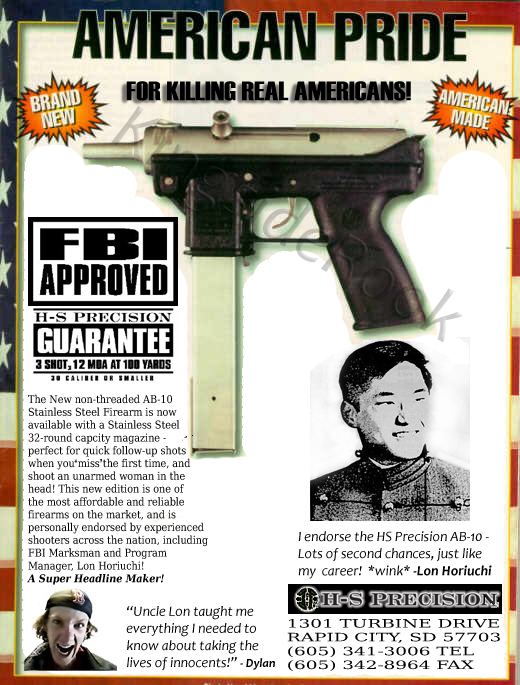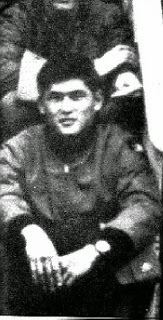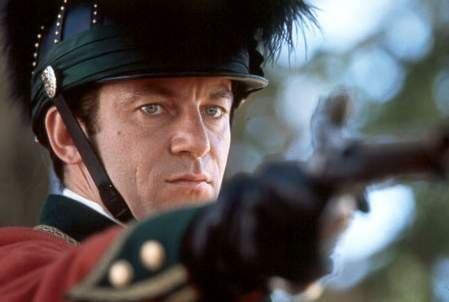Nationality American | Name Lon Horiuchi | |
 | ||
Full Name Lon Tomohisa Horiuchi Known for Ruby Ridge, Waco controversies Education United States Military Academy | ||
Lon Tomohisa Horiuchi (born June 9, 1954) is the American FBI agent who shot Vicki Weaver at Ruby Ridge in 1992. An FBI HRT sniper and former US Army officer, he was involved in controversial deployments during the 1992 Ruby Ridge standoff and 1993 Waco siege. In 1997, Horiuchi was charged with manslaughter for the death of Vicki Weaver at Ruby Ridge, but the charges were later dropped.
Contents

Early life and education

Horiuchi was born on June 9, 1954 in Hawaii as the son of a U.S. Army officer. He later attended the United States Military Academy at West Point, and graduated in 1976. He served as an infantry officer in the U.S. Army. Afterwards he joined the FBI, and by 1999 had been an FBI agent for at least 15 years.
Ruby Ridge

In 1992, while working at sniper position Sierra 4 for the FBI Hostage Rescue Team at Ruby Ridge, Horiuchi shot and killed Vicki Weaver and also wounded her husband, Randy Weaver, and family friend Kevin Harris.

After his first shot hit and wounded Randy Weaver, Horiuchi fired a second shot at Kevin Harris, who was armed, some 20 seconds later as Harris was running into the Weaver home. The bullet fired at Harris struck and killed Vicki Weaver through the doorway just beyond Harris, who was entering the home. Weaver was holding her 10-month-old child behind the door through which Harris was attempting to enter; the round also struck and wounded Harris.
Following the conclusion of the trial of Randy Weaver and Kevin Harris in 1993, the U.S. Department of Justice (DOJ) created a "Ruby Ridge Task Force" to investigate allegations made by Weaver's defense attorney Gerry Spence. On June 10, 1994, the Task Force delivered its 542-page report to the DOJ Office of Professional Responsibility. The Report stated: "With regard to the two shots fired on August 22, we concluded that the first shot met the standard of 'objective reasonableness' the Constitution requires for the legal use of deadly force but that the second shot did not satisfy that standard."
The surviving members of the Weaver family received $3.1M in 1995 to settle their civil suit brought against the U.S. government for wrongful deaths of Vicki Weaver and 14-year-old Samuel Weaver who was killed the day before during an encounter with U.S. Marshals. In the out-of-court settlement, the government did not admit any wrongdoing. Harris received $380,000 in 2000.
Manslaughter charge
In 1997, Boundary County, Idaho Prosecutor Denise Woodbury, with the help of special prosecutor Stephen Yagman, charged Horiuchi in state court with involuntary manslaughter over his killing of Vicki Weaver. The U.S. Attorney filed a notice of removal of the case to federal court, which automatically took effect under the statute for removal jurisdiction where the case was dismissed by U.S. District Judge Edward Lodge on May 14, 1998, who cited the supremacy clause of the Constitution which grants immunity to federal officers acting in the scope of their employment.
The decision to dismiss the charges was reversed by an en banc panel of the Ninth Circuit, which held that enough uncertainty about the facts of the case existed for Horiuchi to stand trial on state manslaughter charges. Ultimately, the then-sitting Boundary County prosecutor, Brett Benson, who had defeated Woodbury in the 2000 election, decided to drop the charges because he felt it was unlikely the state could prove the case and too much time had passed. Yagman, the special prosecutor, responded that he "could not disagree more with this decision than I do."
The Ninth Circuit granted Boundary County's motion to dismiss the case against Horiuchi on September 14, 2001.
Waco
On September 13, 1993, Charles Riley, a fellow FBI sniper deployed during the Waco Siege claimed that he had heard Horiuchi shooting from Sierra 1, an FBI-held house in front of the compound holding eight snipers, including Horiuchi and Christopher Curran on 19 April 1993. Riley later retracted his statement, saying that he had been misquoted, and that he had only heard snipers at Sierra 1 announce that shots had been fired by Branch Davidians. Riley later clarified that he had heard a radio report from Sierra One that someone at that position had witnessed gunfire from within the compound."
Three expended .308 Winchester shell cases, out of the twelve reported by the Texas Rangers to have been found inside the house, were located at the position occupied by Horiuchi. Nonetheless, authorities argue that these casings might have originated from earlier usage of the premises by snipers from the Bureau of Alcohol, Tobacco, Firearms and Explosives on February 28, 1993. Furthermore, they contend that matching the casings to Horiuchi's rifle would be "nearly impossible" due to the likelihood that the rifle has been rebarreled since the incident.
For the five months following the Waco inferno, Timothy McVeigh worked at gun shows and handed out free cards printed with Horiuchi's name and address, "in the hope that somebody in the Patriot movement would assassinate the sharpshooter". He wrote hate mail to the sniper, suggesting that "what goes around, comes around". McVeigh considered targeting Horiuchi, or a member of his family, before settling on a bombing attack on a federal building - choosing to target the Murrah Building.
